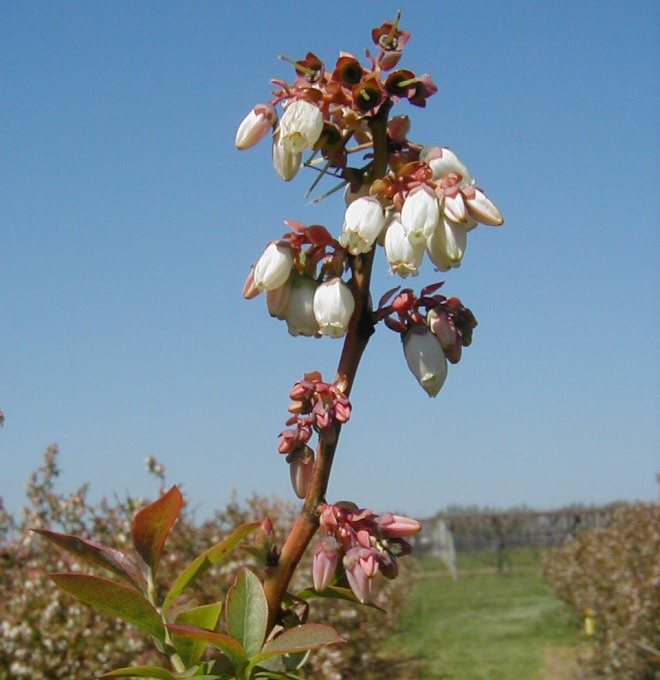Annual growth cycle of northern highbush blueberry
A review of blueberry growth over the year.

In the fall, blueberry bushes are dormant and ready for winter. The blueberry bush uses the clue of shorten day length in late summer to prepare for winter. The next clues are lower temperatures near freezing. Freezing temperatures are the final clue and the bushes go dormant waiting for winter. As long as cold weather does not arrive abruptly, we have little to worry about. The varieties we grow in Michigan could easily handle cold temperatures down to zero degrees Fahrenheit. If the temperatures are below freezing, then the plant can acclimate to the cold and its cold hardiness increases. The maximum cold hardiness for most Michigan varieties is about -18 F. At temperatures below -18 F, we begin to see flower buds die. At colder temperatures, we will see winter injury to leaf buds and shoots.
Woody plants in the temperate zones keep track of winter by tracking chilling units or chilling hours. Our blueberries varieties require about 1,000 hours of chilling. Chilling temperatures are above freezing, between 35 F and 45 F. We probably begin to accumulate chilling hours sometime in November. The plant will not grow until this chilling requirement is completed. If we have long periods of subfreezing weather, this merely delays the completion of dormancy. After the chilling requirement is completed, the plants will begin growth as soon as the conditions for growth are right.
The blueberry bush has two types of buds: flower buds and vegetative buds. The flower buds have only flowers in them and the vegetative buds will only form leaves and shoots. Flower buds are big, plump and easy to see and are usually located at and near the shoot tips. The vegetative buds are small and pointed and are located further down the shoot. The blueberry bush only has buds on last year’s growth. As the buds develop, they lose their ability to withstand really cold temperatures and are harmed by warmer and warmer temperatures. While the swollen buds can withstand temperatures around 10 F, open flowers are killed by temperatures just below freezing.
In the early spring, the buds begin to grow as we have long periods of time above 45 F. The growth of the buds is soon visible as swelling of the buds. The buds at the shoot tips begin growth first, then the buds further down begin to grow (Photo 1). I like it when we get freezing temperatures every night early in the spring because that keeps the growth slow. If we get warm days and warm nights, then the buds really move and you can see differences as the season progresses.
All the different blueberry growth stages have names that describe them. Flower buds swell and then burst, revealing the flower cluster inside. Leaf buds swell and then the new leaves emerge from the buds (green tip) before the bud bursts and the leaves begin to unfold.
The flower buds in blueberries contain a cluster of flowers. There are five to 12 flowers in a cluster. The flowers emerge as a tightly packed cluster. As the flowers develop, the corolla (the petal tube) is visible as pink tissue at the tip of the flowers (pink bud). As the flowers develop, the petal tube expands and the pink fades to white. Bloom begins when the tip of the corolla opens (first bloom).

The flower clusters at the shoot tip begin bloom first, with bloom progressing down the shoot (Photo 2). The flowers at the base of each cluster open first. The first flowers pollenated have the potential to be the largest fruit. Fruit from the latter blooms is smaller. The early period of fruit growth is very important in determining final fruit size. For several weeks, the fruit grows quickly by cell division. Cell division in the fruit then stops, then the fruit grows by cell enlargement. Bigger fruits have more cells, so the final size of the fruit is determined in the month after bloom.
As the fruit begins to grow, the fruit and shoots compete for the available resources and shoot growth slows. As long as we maintain good soil moisture during the growing season, the roots can maintain an adequate flow of water to the leaves to maintain growth. By the time the fruit starts its final swell for harvest, most of the shoot and leaf growth for the season has stopped. Fruit growth takes all the plants energy. When blueberry shoot stops, the tip of the shoot dies. You can actually see the small, withered leaf of the dead shoot tip.
After harvest, the plant prepares for next year’s growth by storing reserves. Under good growing conditions, another flush of shoot growth may begin. Late shoot growth is susceptible to winter injury and normally will not set fruit buds.
In the fall, flower buds are formed for next year’s crop. The terminal shoot bud becomes fat and plump as it changes from a leaf bud to a flower bud. Under good conditions, other leaf buds below the terminal bud will also change to fruit buds.



 Print
Print Email
Email
